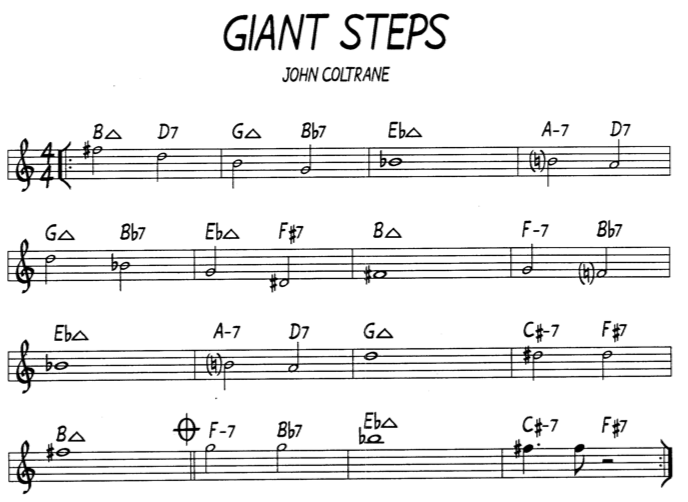Modulation
Historically, early Jazz Standards generally modulate (change key/key centre/tonal centre) in one of three ways:
- Circle of Fifths (G Major to C Major)
- Whole Step (D Major to C Major)
- Chromatic (D♭ Major to C Major)
Coltrane Changes
But why only use these intervals when modulating? Why can’t we use other intervals? Well, this is the idea behind Coltrane Changes – they change keys by intervals of Major 3rds (E Major to C Major).
| Cycle of Fifths | D7 | GMaj7 | G7 | CMaj7 |
| Whole Step | A7 | DMaj7 | G7 | CMaj7 |
| Chromatic | A♭7 | D♭Maj7 | G7 | CMaj7 |
| Coltrane Changes | Dm7 - E♭7 | A♭Maj7 - B7 | EMaj7 - G7 | CMaj7 |
Note: The keys through which Coltrane Changes modulate create an Augmented Triad: C, A♭, E, C.
John Coltrane did NOT invent modulation through intervals of Major 3rds. This technique had been used before (See Section B of Have You Met Miss Jones?). But Coltrane was the first person to use this technique extensively in Jazz.

Reharmonization
Coltrane Changes can be used to reharmonize the following progressions:
- II-V-I
- III-VI-II-V
- I-VI-II-V
| II-V-I | Dm7 | G7 | CMaj7 | CMaj7 |
| Coltrane #1 | Dm7 | G7 | EMaj7 - G7 | CMaj7 |
| Coltrane #2 | Dm7 - E♭7 | A♭Maj7 - B7 | EMaj7 - G7 | CMaj7 |
| III-VI-II-V-I | Em7 - A7 | Dm7 - G7 | CMaj7 | CMaj7 |
| Coltrane | Em7 - E♭7 | A♭Maj7 - B7 | EMaj7 - G7 | CMaj7 |
| I-VI-II-V-I | CMaj7 - A7 | Dm7 - G7 | CMaj7 | CMaj7 |
| Coltrane | CMaj7 - E♭7 | A♭Maj7 - B7 | EMaj7 - G7 | CMaj7 |
We already discuss the importance of ‘structure’ in music in a previous lesson (on Cycle Patterns). Well, Coltrane Changes work well in a reharmonization because the chords move in a structured way (i.e. in fixed intervals). We will discuss reharmonization (and the importance of structure in reharmonization) in detail in the next module.
And of course, there’s no reason to stick to only modulating in intervals of Major 3rds. You can change key centres by any (fixed repeating) interval and it will sound good precisely because the interval is fixed and repeating (again, this is very similar to the idea of Cycled Patterns).
Using Other Intervals
So we can change key using the following intervals:
- 1 semitone = Half-step
- 2 semitone = Whole-step
- 3 semitone = min 3rd (we can call this ‘Minor Coltrane Changes‘ – this creates a diminished 7th chord)
- 4 semitone = Maj 3rd (Original Coltrane Changes – creates an augmented chord)
- 5 semitone = Perfect 4th (Standard Circle Progression)
- 6 semitone = Tritone (= two min 3rds)
- etc…
| II-V-I | Dm7 | G7 | CMaj7 | CMaj7 |
|---|---|---|---|---|
| Minor Coltrane | E7 - AMaj7 | D♭7 - G♭Maj7 | B♭7 - E♭Maj7 | G7 - CMaj7 |
| Tritone Coltrane | D♭7 | G♭Maj7 | G7 | CMaj7 |
Have a Listen to
The following Coltrane songs all use the Standard (Major 3rd) Coltrane Changes, with the exception of the last one which modulates by intervals of minor 3rds.
- Giant Steps
- Countdown
- 26-2
- Satellite
- Exotica
- Fifth House
- Central Park West (Minor Coltrane Changes)